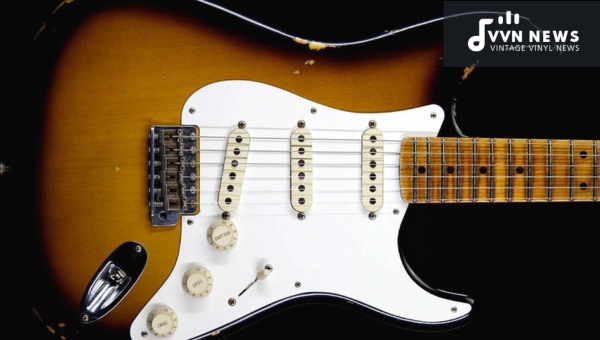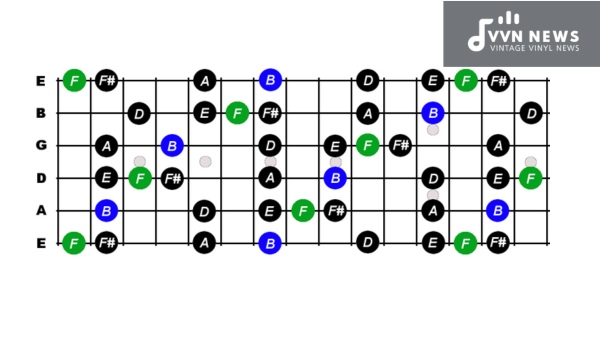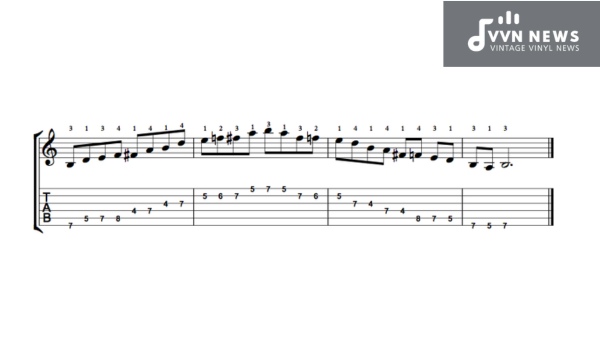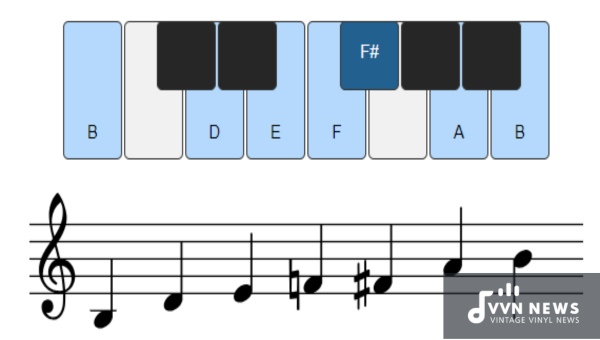The B minor blues scale is an incredibly versatile tool in the arsenal of musicians, offering a rich tapestry of sounds for crafting soulful solos and spine-tingling melodies.
It’s the secret ingredient that adds that smoky flavor to a blues tune, and it provides the framework for improvisation across a variety of musical genres, from rock to jazz to country.
Navigating through the notes of the B minor blues scale opens up a world of expression and emotion for guitarists and pianists alike.
It’s remarkable how just six simple notes can convey such a profound range of feelings.
In this article, we’ll demystify the nuances of this scale, showing you how each note contributes to its overall mood and how mastering it can transform your musical expression.
Whether you’re just starting out or looking to refine your skills, the journey through the B minor blues scale is both rewarding and thrilling.
Breakdown of the B Minor Blues Scale
The B minor blues scale is a pentatonic scale with an added ♭5th, lending it a distinctive, edgy sound. Here’s its formula:
- B (Root)
- D (Minor 3rd)
- E (Perfect 4th)
- F (Blue Note – ♭5th)
- F♯ (Perfect 5th)
- A (Minor 7th)
These notes provide the somber, yet colorful palette from which countless melodies can be painted.
This scale thrives over a B minor chord or progression, igniting solos with depth and feeling.
It’s the voice of the blues, encapsulating its raw emotion through each pitch.
By weaving in the blue note, you infuse traditional lines with that quintessential bluesy feel that is both familiar and heart-stirring.
Also Read: F Minor Blues Scale [Experiment With This Dark & Moody Key]
Shapes of B Minor Blues Scale

The B minor blues scale is a fascinating entity; it’s not just a sequence of notes but a chameleon adapting to various positions across the fretboard.
These positions, or shapes, are critical to understanding because they allow you to navigate the neck with ease and expressiveness. Let me guide you through five essential shapes of this enigmatic scale.
Shape 1: The Root Position
Starting at the 7th fret:
Place your index finger on the low E string, seventh fret (the root note, B). This shape sprawls across four frets – from the 7th to the 10th – and is your first port of call for blues improvisation. Here is how it looks:
- E string: |7 (B) – 10 (D)|
- A string: |7 (E) – 8 (F) – 9 (F#)|
- D string: |7 (A) – 9 (B)|
- G string: |7 (D) – 9 (E)|
Move this pattern up an octave, and you can continue your bluesy crusade higher up the neck.
Shape 2: The Fourth Interval
Spanning from the A string:
Your root note still starts over on your A string but now at the second fret. This shape feels familiar to those who’ve mastered pentatonic scales since it nests within that framework.
You use fingers one and three predominantly, stretching out across three frets:
- A string: |2 (B) – 5 (D)|
- D string: |2 (E) – 3 (F) – 4 (F#)|
Shape 3: The Box Shape
Often revered as the go-to pattern when soloing in blues:
- G string: |4(A)-7(B)-9(D)|
It’s compact and ideal for quick riffs or expressive bends.
Shape 4: The Extended Slide
This version incorporates a slide between positions:
- B string: Slide from |3(F#)-5(E)-6(F)-10(B)|
It adds a sense of fluidity and extension beyond typical boxed patterns.
Shape 5: The Two-Octave Stretch
Covering more than two octaves:
- High E-string stretch from |7(B)-12(D)-14(E)|
Learning these shapes individually will empower you to cover every inch of your instrument’s neck in B minor’s moody hues.
Emphasize memorizing one shape at a time before connecting them seamlessly to expand your musical vocabulary.
Also Read: E Minor Blues Scale [Bring Emotional Tension To Your Music]
Major and Minor Elements in B Minor Blues
The B minor blues scale is a mesmerizing blend of the B minor pentatonic scale with an added flat fifth, or the “blue” note.
This scale traditionally comprises the following notes: B, D, E, F, F#, and A.
The interplay between the major and minor elements within this scale is what gives blues music its distinctive sound – a sound that’s both sad and rebellious.
While rooted in minor tonality, the blue note (F) introduces a touch of major tension, creating a sonic dissonance that’s characteristic of blues music.
This bending of pitches is pivotal in expressing the fiery core of blues. For instance, when you hover between the F and F# notes on your instrument, you embrace the heartache inherent within each blues phrase while also infusing hopeful resolution.
What makes the B minor blues scale particularly rich is how it incorporates both sadness from its minor components (rooted in notes like B and D) alongside moments of uplifting major relief (hinted at by touchpoints like F#).
The constant dance between these contrasting emotional landscapes paints an auditory picture that resonates with listeners’ deepest sentiments.
B Minor Blues Rhythm Tracks

Rhythm tracks form the backbone of a blues progression and influence the emotive palette upon which you’ll paint with your B minor blues scale solos.
In essence, your choice of rhythm track provides the setting for your musical storytelling.
When we speak of rhythm tracks in the key of B minor, we’re looking at several compelling foundations that vary in tempo, groove, and complexity.
Also Read: E Flat Minor Blues Scale [Infuse Your Tunes With Moody Blues]
Traditional 12-Bar Blues Progression
A classic 12-bar blues in B minor typically consists of the I-IV-V chord pattern.
Here, you’d have the B minor chord (I), the E minor chord (IV), and the F#7 chord (V) making up your primary sequence.
This rhythm track will have a steady, march-like tempo that’s perfect for digging into those soul-stirring blues phrases.
Slow Blues
For those profound moments when you want to wring every drop of emotion from your notes, a slow blues track can be your best friend.
The laid-back tempo allows more space between chords, giving you ample time to explore bends, vibratos, and expressive techniques within your scale patterns.
Shuffle Groove
Incorporating a shuffle groove adds an element of swing to your rhythm track. It redefines straight eighth notes into a lilting “long-short” pattern that invites a more laid-back interpretation of the B minor blues scale.
The shuffle feels like it’s swinging back and forth much like a pendulum making it both relaxed and energetic.
Funky Blues
To dial up the energy, funk-infused rhythms with syncopated patterns and staccato hits offer an exciting environment for experimentation with timing and phrasing in your playing.
You’ll notice how different positions on the fretboard may complement these percussive beats differently when using them within improvisation or structured play.
Each rhythm track serves as a different type of conversation with specific ebbs and flows – some are reflective musings while others are vibrant dialogues.
When practicing improvisation over these rhythms using the B Minor Blues Scale, focus on how certain notes resonate against particular chords and how different rhythmic feels inspire unique responses from you as a player.
Also Read: C Minor Blues Scale [Guitar Guide For Passionate Players]
Why is Ear Training Key for Blues Scales?
Ear training is an essential component in mastering the blues scale, particularly in B minor.
By fine-tuning your ears, you become adept at recognizing the distinct sounds and intervals that give the blues its characteristic feel.
Here’s why prioritizing ear training can elevate your musicianship when navigating blues scales:
Enhanced Note Recognition
The ability to identify notes and intervals by ear allows for swift translation from thought to fingers. You move beyond simply knowing the scale patterns to feeling them intuitively.
Improvisational Freedom
Blues is all about expression and improvisation. Ear training equips you with the proficiency to weave in and out of scales seamlessly, encouraging spontaneous musical conversations.
Emotional Connection
The emotional pull of blues comes from subtle nuances in bending, vibrato, and dynamics.
Training your ears sharpens your sensitivity to these expressions, enabling you to convey deeper emotions through your instrument.
Playing by Ear
For many musicians, being able to play by ear is the pinnacle achievement. With a well-trained ear, picking up new songs or jamming with other musicians becomes a breeze.
Developing an ear for the blues isn’t just about technique; it’s about crafting a bond between you and your music that goes deeper than notes on a page.
It’s an investment in musical fluency—the kind that resonates with listeners and unearths the raw beauty of the blues genre.
B Minor Blues’ Musical Genre Effects

The B minor blues scale is a potent entity that casts an expansive shadow over various musical genres, subtly altering their sonic landscapes.
Its usage brings a distinctive flair to songs and compositions, offering a melancholic twinge or introspective depth that can define the essence of a track.
In Rock Music
In rock, the scale’s integration adds a layer of raw emotion. Famed guitar solos in classic rock anthems frequently dip into the B minor blues scale to evoke feelings of rebellion and intensity.
The use of this scale can typically be found in the work of legendary artists like Jimi Hendrix and Eric Clapton, where it provides a touchstone for their improvisational prowess.
Jazz and Fusion
Jazz musicians often leverage the B minor blues to inject a soulful, moody vibe into their improvisations or melodies.
It’s all about tension and release – with those additional blue notes creating a dissonance that resolves beautifully within the structure of jazz harmony.
Here, it’s not just about the notes played but how they’re played — timing and expression are key.
R&B/Soul
In realms of R&B and soul, employing the B minor blues scale offers richness to vocal lines and instrumental solos alike.
Consider iconic songs by Aretha Franklin or Stevie Wonder, where elements of blues scales underpin so much of their timeless appeal — they’re infused with complex emotionality, thanks to these scales.
The effects are as diverse as music itself; from country licks evoking images of dusty roads to hip-hop samples adding grit to beats.
The versatility shines through because it allows artists across genres to tap into something intrinsically human: the expression of sorrow mixed with beauty, struggle interlaced with hope.
Also Read: G Major Blues Scale [Expand Your Harmonic Possibilities]
FAQs about the B Minor Blues Scale
What is the B Minor Blues Scale?
The B Minor Blues Scale is a six-note scale that is pivotal for creating emotional solos and melodies in blues and other genres.
Can the B Minor Blues Scale be used over major chords?
Yes, it can be used over major chords to add a bluesy feel, especially if those chords are part of a 12-bar blues progression.
How do I practice the B Minor Blues Scale?
Practice by playing the scale ascending and descending, then experiment with creating licks and improvising over backing tracks.
Where can I hear the B Minor Blues Scale in popular music?
Listen for it in classic blues tunes as well as rock songs that have a blues influence—they often include solos that utilize this scale.
Can I use the B Minor Blues Scale in other keys?
Certainly! Transpose of the scale pattern to start on a different root note to play it in other keys, preserving its characteristic intervals.
Conclusion
Diving into the B minor blues scale is a journey well worth embarking on for any musician.
It’s a melding of emotive depth and versatility that can transform your playing.
By incorporating the scale into your practice, you’ll not only enrich your improvisational skills but also refine your musical ear to hear those subtle nuances that make blues so distinctive.
Remember, consistent practice and listening will expedite your mastery.
Embrace every note in this scale, and you’ll soon unlock new realms of musical expression that resonate with listeners on a profound level.








